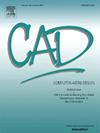Blending weight BSP Tree for mesh Boolean operations
IF 3.1
3区 计算机科学
Q2 COMPUTER SCIENCE, SOFTWARE ENGINEERING
引用次数: 0
Abstract
Boolean operations play an important role in geometry processing and CAD/ CAM. To accelerate it, spatial searching trees such as Binary Space Partitioning (BSP) Trees and KD-trees are utilized. In this paper, an approach is presented to construct the BSP Trees for the Boolean operation, where each model is efficiently located in a separate subspace. Unlike conventional methods to calculate the splitting plane, our method utilizes a size-distribution blending weighted squared distance in the BSP Tree construction, where the intrinsic weight is determined based on the size and distribution of the three-dimensional (3D) model and largely reflects the model shape. After determining the intrinsic size-distribution blending weighted squared distance, the effective splitting plane is calculated using the Weighted Squared Distance Minimization (WSDM) method. By utilizing the size-distribution blending weighted squared distance, the generated BSP Tree can divide the two models efficiently, even when dealing with 3D models that exhibit substantial geometric variations. In our experiments, the BSP Tree generated by our method reaches higher Intersecting Triangle Report Accuracy (ITRA) and Non-intersecting Triangles Removal Rate (NTRR), which means more efficient hierarchies than other techniques on two mesh models. The results of intersection tests time consumption and the Boolean operations demonstrate the effectiveness and efficiency of the BSP Tree generated by our method.

混合权重BSP树用于网格布尔操作
布尔运算在几何加工和CAD/ CAM中起着重要的作用。为了加快速度,利用了二进制空间划分树(Binary Space Partitioning, BSP)和kd树等空间搜索树。本文提出了一种构造布尔运算的BSP树的方法,其中每个模型都有效地定位在单独的子空间中。与计算分裂平面的传统方法不同,我们的方法在BSP树构建中使用了尺寸-分布混合加权平方距离,其中内在权重是根据三维(3D)模型的大小和分布确定的,并且很大程度上反映了模型的形状。在确定固有尺寸-分布混合加权平方距离后,使用加权平方距离最小化(WSDM)方法计算有效分割平面。通过利用尺寸-分布混合加权平方距离,生成的BSP树可以有效地划分两个模型,即使在处理具有明显几何变化的3D模型时也是如此。在我们的实验中,我们的方法生成的BSP树达到了更高的相交三角形报告精度(ITRA)和非相交三角形去除率(NTRR),这意味着在两个网格模型上比其他技术更有效的层次结构。交叉测试耗时和布尔运算结果验证了该方法生成的BSP树的有效性和高效性。
本文章由计算机程序翻译,如有差异,请以英文原文为准。
求助全文
约1分钟内获得全文
求助全文
来源期刊

Computer-Aided Design
工程技术-计算机:软件工程
CiteScore
5.50
自引率
4.70%
发文量
117
审稿时长
4.2 months
期刊介绍:
Computer-Aided Design is a leading international journal that provides academia and industry with key papers on research and developments in the application of computers to design.
Computer-Aided Design invites papers reporting new research, as well as novel or particularly significant applications, within a wide range of topics, spanning all stages of design process from concept creation to manufacture and beyond.
 求助内容:
求助内容: 应助结果提醒方式:
应助结果提醒方式:


